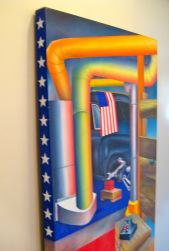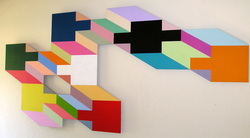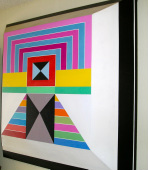|
WHAT IS HARD-EDGE PAINTING? A number of Joe Rice’s most beloved works of the late 1960s and early 1970s are in the hard-edge style, painted on either canvas or masonite board. The paintings on canvas are generally executed in a wraparound manner; in addition to the front or outfacing surface, the side strips are also painted (top). A handful of his hard-edge works employ shaped canvasses of his own construction; such as one that resembles a squat, flat-topped pyramid shape (bottom); the sides taper inward to form the pyramid's top. The painted surface for a long narrow painting on masonite board is intricately cut so that it mirrors the painting's precise geometric blocks of color (middle). Hard-edge painting is an abstract style generally characterized by an emphasis on the flatness of the surface, clean-edges and monochromatic geometric areas of color. The term “hard-edge abstraction” is attributed to California art critic Jules Langsner, and was initially devised as the title for a 1959 exhibition (Los Angeles County Art Museum, San Francisco Museum of Modern Art) of four West Coast artists - Karl Benjamin, John McLaughlin, Frederick Hammersley and Lorser Feitelson. Due to the California origin of the term the style is sometimes referred to as “California hard-edge” or "West Coast hard-edge." Other painters associated with hard-edge include Frank Stella (also known for his shaped canvases) and Kenneth Noland. |



